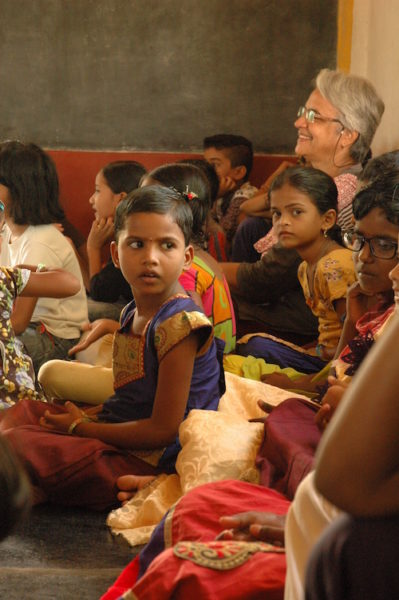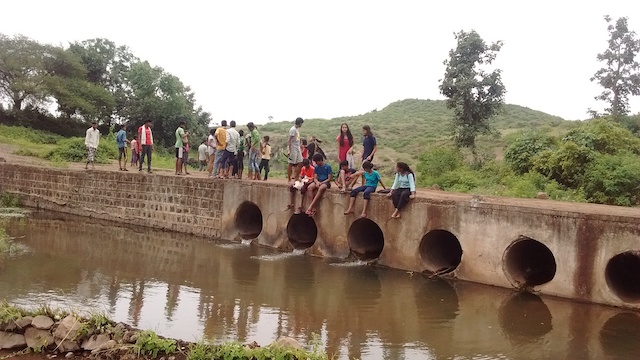In Swahili, Mtoto means Child.
Our bi-annual Mela this school year focused on learning about the lives of children in various parts of the world and in a various parts of Central to South India.
Every year, we journey to places from as close as Coorg in Karnataka to Assam in the East, Kutch in the West and the Eastern Himalaya. It is a time when we engage with people and places and over the years, has been an immense learning about the world around and our own place in it.
This year, we were keen to make a concerted endeavour to make friends with children we may not otherwise meet, to learn about them and from them and to share about ourselves as well. We hoped to broaden our own perspectives and feelings of what is to be a child.
We wondered if in this process of mutual encounter we would see that being a child and the process of childhood has many avatars. We worked in four groups of students and teachers.
We travelled to parts of Bangalore, spending enriching days at several schools. These included the Annaswamy Mudaliar Academy in Fraser town, founded in 1907. Warm sharings happened between young adults. There was song and play.
 We visited children at the Association of People with Disabilities and hosted them at CFL as well. Here too, we were welcomed with grace and warmth. We visited neighbouring Bachenhatii school, where children came together around energetic games. We visited Ananya school, where too, it was a day of getting to know one another through games and craft.
We visited children at the Association of People with Disabilities and hosted them at CFL as well. Here too, we were welcomed with grace and warmth. We visited neighbouring Bachenhatii school, where children came together around energetic games. We visited Ananya school, where too, it was a day of getting to know one another through games and craft.
We reached out to children and adults in select regions of the world and regions of the subcontinent. We explored our own notions of childhood. Our youngest lot (by now called the Lat Bats after their assigned region of Latin America) shared a poster on What is a Child? Amongst the many thoughts shared here, one was: Every Adult has a Child in them.
We began to contact schools who may exchange letters and voice mails and video calls. Excitedly, adults wrote to all manner of contacts and “leads”. We suddenly remembered people we’d known from our past lives, friends in different corners of the world. A soccer coach in Ghana, an ex-student, now engaged in Conservation work in Chile.
Large maps of Latin America, the Middle East, Eastern and Western Africa and the Indian Subcontinent went up in our dining area. Small presentations occurred at assembly. Our middle schoolers shared a short film: A conversation with young friends in Ghana, filmed atop our library tower.
Along with repeated tos and fros of ‘Where do you live?’ and “What are your interests?’ was laughter from the film makers themselves who were thoroughly enjoying the work of being camera people.
We sang De Colores, a Joan Baez rendition in Spanish. We listened to and practiced Tibetan phrases.
And so there was correspondence, between Us and our not so nearby friends. As well as between Us and friends who, we would soon visit in their schools and homes. Handwritten letters and Emails travelled to Chile, Chiapas, Ghana, Kenya, Thailand, Nepal.
As well as to Chattisgarh, Madhya Pradesh, Kutch, Northern and SW Karnataka, Tamil Nadu and Andhra Pradesh. These were precursor to actual “trips”. Our usual yearly excursions happened to people and places we had been in touch with. And already, we were busy preparing for two separate weeks of our Mtoto Mela when children and adults would visit CFL.
We called these two weeks the “Mtoto mela or Children’s Conference”.

The process of conceiving and planning the Mtoto conference was both exciting and demanding. Students formed several committees which took on work in various areas. There was the Kitchen Committee, the Hospitality Committee, the Timetable Committee, the Resource Committee, the Infastructure Committee, the Transport Committee. Overnight, a Parallel Government of sorts arose, able to take on all of the required to run key aspects of not just a conference but of a school itself! Every student was part of a committee and every student took their membership seriously. Being a committee member meant both doing tasks as well as helping to keep an entire group process going. Listening, sharing, imagining, being patient, sorting out differences, learning when to step in and when to invite those who stayed on the edge. Committees adopted teachers as guides. But depending on the work, committee members took on a huge amount of work themselves.

The Conference Weeks had entire townships alive on the CFL campus. And all of the students rose to the occasion of holding the Conference with a warm sense of ownership. There were many spaces to meet children and adults.
Children from other parts of the country brought their stories to CFL. During the conference weeks we had long assemblies, where all gathered and narrated the histories of their schools and the wider stories of their lives.
Childhoods
And now, some recollections and reflections on our Mela theme: Childhoods.
We met children in rural parts of Tamil Nadu, Chattisgarh, Kutch, Madhya Pradesh and Karnataka. We received letters from children as far away as Puerto Guadal in Chile.
Some themes of Childhood spread across the lives of many friends we made.
Childhood is work.
All children work in some way or the other, at home and in school.
Childhood for some means coming home in the evening and gathering firewood for the evening and fodder for your goat. Or looking after the cows that live in the school community: Taking them out to graze, giving them water, milking, washing.
Childhood for many means helping to run a kitchen. Cooking, cleaning, planning, keeping a system going.
Childhood for many means being responsible for younger children.
 Some of the young adults we met had barely had a childhood. Their lives moved from little formal schooling at all, to leaving school and home and having to earn their own keep young, to now dedicated learning of artisanship (carpentry, masonry): expertise that will bring a livelihood.
Some of the young adults we met had barely had a childhood. Their lives moved from little formal schooling at all, to leaving school and home and having to earn their own keep young, to now dedicated learning of artisanship (carpentry, masonry): expertise that will bring a livelihood.
Childhood for many includes a chance for creative expression, and for some, to truly delve into areas of the arts such as classical music and dance.
We met with an abundance of song and craft and drama. The music, dance and drama told stories of people’s lives.
Some of the children we wrote to make crafts such as bead necklaces and earrings which they take to the local market in their town.
Childhood is play and abandon! From playing marbles and football and Frisbee, children have a great time just playing!
Young people from Central India put the circle of seasons vividly to song:
Jamun fruits falling when the rain comes, a woman off to her khet (field), the child left behind in tears, boys playing the flute and dancing, as they work in fields.
To sing is to tell about your life.
 Childhood means participation in the larger plans of the school, helping to organize, bringing in your ideas. In one instance, young people announced that they wanted more time to study for exams. It was a shift from a earlier school time that allowed more space for spontaneity. They made sure the time table had time to prepare for imminent exams.
Childhood means participation in the larger plans of the school, helping to organize, bringing in your ideas. In one instance, young people announced that they wanted more time to study for exams. It was a shift from a earlier school time that allowed more space for spontaneity. They made sure the time table had time to prepare for imminent exams.
Childhood is a Tapestry of Personalities and Emotions.
We were surrounded and inspired by children who were at once: generous, warm, kind, strong-minded, loving, defenceless, vulnerable, silent, shy, vibrant, smiling, contemplative, articulate, sophisticated, determined, kind, independent, playful and sensitive.
For some, childhood is filled with a longing for a lost homeland. For some, childhood merges seamlessly into adulthood, young members of families and communities taking on the responsibilities of adults.
The Mtoto Mela was incredibly moving in many ways.
We were overwhelmed by the generosity and warmth of communities we stayed with. Our lives are even wider now, with friends we may write to any time, and with a sense of deeper connect with people in pockets of now familiar worlds.
~ Diba
